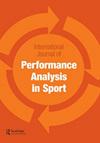Performance rating in men’s world elite artistic gymnastics: a status-quo study on scoring tendencies at Olympic Games following rule changes
IF 1.6
4区 教育学
Q1 Health Professions
International Journal of Performance Analysis in Sport
Pub Date : 2023-07-28
DOI:10.1080/24748668.2023.2240673
引用次数: 0
Abstract
ABSTRACT In artistic gymnastics, rule changes in the year 2006 aimed to reduce the dominance of difficulty while strengthening performance differentiation. Related research on scorings often refers to analysing the proportion of difficulty and execution scores. For this, several studies preferred analyses of punctual major competitions predominantly neglecting long-term effects on performance differentiation. Therefore, the present study aimed to examine the effects of the International Gymnastics Federation’s (FIG) modified performance rating system on the importance of execution and difficulty and performance differentiation in men’s world elite artistic gymnastics following rule changes. The results’ lists of the five recent Olympic Games (i.e. qualification competitions of Athens 2004, Beijing 2008, London 2012, Rio 2016 and Tokyo 2021) including the difficulty, execution and final scores of the TOP20-ranked gymnasts in each event were analysed. Compared to Athens 2004, results revealed significantly enhanced performance differentiation (p < .01) with the execution score nowadays to predict the final score (p < .01). However, both general findings need to be discussed with respect to apparatus-specific phenomena. We suggest these findings to reflect positive impacts of rule changes on performance rating in world elite men’s artistic gymnastics due to intended scoring tendencies.世界优秀艺术体操男子成绩评定:规则变化后奥运会得分趋势的现状研究
摘要在艺术体操中,2006年规则的改变旨在减少难度的主导地位,同时加强表演的差异化。关于评分的相关研究通常涉及分析难度和执行得分的比例。为此,几项研究倾向于对准时的主要比赛进行分析,主要忽略了对表现差异的长期影响。因此,本研究旨在检验国际体操联合会(FIG)修改后的成绩评分系统对世界男子精英艺术体操规则变化后执行力、难度和成绩差异的重要性的影响。分析了最近五届奥运会(即2004年雅典奥运会、2008年北京奥运会、2012年伦敦奥运会、2016年里约奥运会和2021年东京奥运会)的成绩表,包括各项目排名前20的体操运动员的难度、执行力和最终成绩。与2004年雅典奥运会相比,结果显示,表现差异显著增强(p < .01)与现在的执行得分来预测最终得分(p < .01)。然而,这两个普遍的发现都需要就特定于仪器的现象进行讨论。我们认为这些发现反映了由于预期得分倾向,规则变化对世界优秀男子艺术体操成绩评分的积极影响。
本文章由计算机程序翻译,如有差异,请以英文原文为准。
求助全文
约1分钟内获得全文
求助全文
来源期刊

International Journal of Performance Analysis in Sport
SPORT SCIENCES-
CiteScore
4.70
自引率
4.80%
发文量
38
审稿时长
>12 weeks
期刊介绍:
The International Journal of Performance Analysis in Sport aims to present current original research into sports performance. In so doing, the journal contributes to our general knowledge of sports performance making findings available to a wide audience of academics and practitioners.
 求助内容:
求助内容: 应助结果提醒方式:
应助结果提醒方式:


